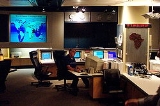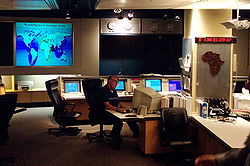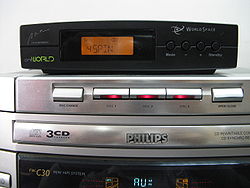
AfriStar
Encyclopedia
AfriStar is a satellite
family, operated by 1worldspace.
The orbiting satellites and the satellite in storage were built by Alcatel Space and EADS Astrium
, formerly known as Matra Marconi Space. Based on the Astrium's Eurostar E2000+
bus design, the geostationary orbit
satellites broadcast digital radio programs in the L-Band frequency (1452-1492 MHz range).
Each of the satellites has three downlink spot beams, with each beam covering approximately 14 million square kilometers of the earth.
Plans to launch a third satellite, AmeriStar (a.k.a. CaribStar), to serve South America
, Latin America
, and the Caribbean
from 95.0° west longitude
were not carried out as the L-band frequencies used by 1worldspace are commandeered by the United States Air Force
. This satellite was reconfigured and is now known as AfriStar 2. AfriStar 2 was to be launched to 21.0° east longitude
in August 2007.
This satellite, not yet launched as of the present, is intended to expand coverage for Western Europe in addition to the existing coverage of AfriStar 1, which it will eventually replace. 1worldspace will use ETSI Satellite Digital Radio (SDR) open standard in the new European coverage beam. It is currently in storage at EADS Astrium’s and Thales Alenia Space facilities in Toulouse, France and Stevenage, U.K. A fourth satellite of identical design, for which long lead parts have been procured and partially assembled, is also maintained in storage in Toulouse, France and can be integrated and tested for launch in an abbreviated period of time.


 Each satellite has a design life of twelve years, with an orbital maneuver life of 15 years, which means that each satellite has been designed and fueled to maintain its assigned orbital position (within 0.1 degrees) for 15 years. After that point, the satellite must be decommissioned.
Each satellite has a design life of twelve years, with an orbital maneuver life of 15 years, which means that each satellite has been designed and fueled to maintain its assigned orbital position (within 0.1 degrees) for 15 years. After that point, the satellite must be decommissioned.
The AfriStar satellite has developed a defect in its solar panels. As a result of this defect, the energy collected by those panels is less than intended.
In March 2010, WorldStar announced that it was considering disposing of its satellites by boosting them to a higher orbit and expending their remaining fuel.
Satellite
In the context of spaceflight, a satellite is an object which has been placed into orbit by human endeavour. Such objects are sometimes called artificial satellites to distinguish them from natural satellites such as the Moon....
family, operated by 1worldspace.
The orbiting satellites and the satellite in storage were built by Alcatel Space and EADS Astrium
EADS Astrium
Astrium Satellites is one of the three business units of Astrium, a subsidiary of EADS. It is a European space manufacturer involved in the manufacture of spacecraft used for science, Earth observation and telecommunication, as well as the equipment and subsystems used therein and related ground...
, formerly known as Matra Marconi Space. Based on the Astrium's Eurostar E2000+
Eurostar (spacecraft)
Eurostar is the brand name for a satellite bus made by Astrium which has been used for a series of spacecraft providing telecommunications services in geosynchronous orbit . More than 60 Eurostar satellites have been ordered to date, of which 45 have been successfully launched since October 1990...
bus design, the geostationary orbit
Geostationary orbit
A geostationary orbit is a geosynchronous orbit directly above the Earth's equator , with a period equal to the Earth's rotational period and an orbital eccentricity of approximately zero. An object in a geostationary orbit appears motionless, at a fixed position in the sky, to ground observers...
satellites broadcast digital radio programs in the L-Band frequency (1452-1492 MHz range).
Each of the satellites has three downlink spot beams, with each beam covering approximately 14 million square kilometers of the earth.
Plans to launch a third satellite, AmeriStar (a.k.a. CaribStar), to serve South America
South America
South America is a continent situated in the Western Hemisphere, mostly in the Southern Hemisphere, with a relatively small portion in the Northern Hemisphere. The continent is also considered a subcontinent of the Americas. It is bordered on the west by the Pacific Ocean and on the north and east...
, Latin America
Latin America
Latin America is a region of the Americas where Romance languages – particularly Spanish and Portuguese, and variably French – are primarily spoken. Latin America has an area of approximately 21,069,500 km² , almost 3.9% of the Earth's surface or 14.1% of its land surface area...
, and the Caribbean
Caribbean
The Caribbean is a crescent-shaped group of islands more than 2,000 miles long separating the Gulf of Mexico and the Caribbean Sea, to the west and south, from the Atlantic Ocean, to the east and north...
from 95.0° west longitude
95th meridian west
The meridian 95° west of Greenwich is a line of longitude that extends from the North Pole across the Arctic Ocean, North America, the Gulf of Mexico, Central America, the Pacific Ocean, the Southern Ocean, and Antarctica to the South Pole....
were not carried out as the L-band frequencies used by 1worldspace are commandeered by the United States Air Force
United States Air Force
The United States Air Force is the aerial warfare service branch of the United States Armed Forces and one of the American uniformed services. Initially part of the United States Army, the USAF was formed as a separate branch of the military on September 18, 1947 under the National Security Act of...
. This satellite was reconfigured and is now known as AfriStar 2. AfriStar 2 was to be launched to 21.0° east longitude
21st meridian east
The meridian 21° east of Greenwich is a line of longitude that extends from the North Pole across the Arctic Ocean, the Atlantic Ocean, Europe, Africa, the Indian Ocean, the Southern Ocean, and Antarctica to the South Pole....
in August 2007.
This satellite, not yet launched as of the present, is intended to expand coverage for Western Europe in addition to the existing coverage of AfriStar 1, which it will eventually replace. 1worldspace will use ETSI Satellite Digital Radio (SDR) open standard in the new European coverage beam. It is currently in storage at EADS Astrium’s and Thales Alenia Space facilities in Toulouse, France and Stevenage, U.K. A fourth satellite of identical design, for which long lead parts have been procured and partially assembled, is also maintained in storage in Toulouse, France and can be integrated and tested for launch in an abbreviated period of time.



The AfriStar satellite has developed a defect in its solar panels. As a result of this defect, the energy collected by those panels is less than intended.
In March 2010, WorldStar announced that it was considering disposing of its satellites by boosting them to a higher orbit and expending their remaining fuel.

